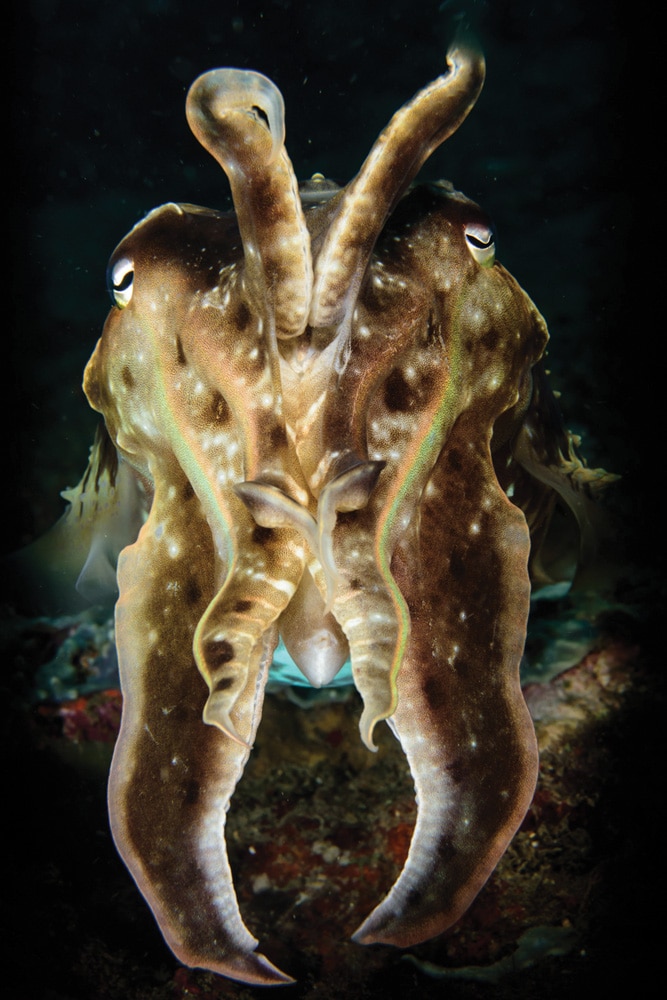News
Review: The Underwater Photographer by Martin Edge

It must be over 15 years ago that I bought my first copy of The Underwater Photographer by Martin Edge. It was recommended to me by fellow photographers as the go-to resource for those looking to improve their underwater shots and it has been a constant companion. The first edition was published back in 2004 and now the 5th (and final) revision of this much-loved book has been released in print and as an ebook.
I was asked to review the ebook, and while I was excited to get my hands on the new edition, I thought that I would prefer the print edition, as a reference book to peruse at my leisure. However, as soon as I opened up the ebook I knew that this was a vauable resource in this format. Why? Well, it is easy to travel with, you can add notes and highlight sections (without damaging a much loved print edition), you can easily search for a particular topic you would like to learn more about.

Whilst both compositions are credible the sun beams come out on top every time. Always consider the image frame orientation option before you shoot. F 20, 1/320th sec, shutter speed. Tokina 10 – 17 at 17mm. ISO 1600. In low early morning light.
This new book has a huge amount of information to digest and takes the underwater photographer on a path of learning that is easy to follow. This edition sees guest chapters from well-known underwater photographers that are experts in their particular fields, for example, there is a chapter from Alex Mustard on optics and a chapter on super macro from Alex Tattersall.

I’ve composed just enough base beneath the bottom of the frame to give some context. Too much base will be interpreted as ‘wasted space or dead space’. Nikon D7200, f 16 at 1/250th sec, Iso 200, two Inon strobes placed each side of my macro port to illuminate both sides of the cuttle fish as it moved around whilst I was shooting. This image above was the precise composition I was trying to achieve. I remember trying to make sure to keep both the tentacles within the bottom frame. This doesn’t mean it’s a great picture but it means that I achieved exactly what I was after. Tokina 10mm to 17mm lens on the 17mm end.
The book is packed with useful information and one of my favourite parts of the book are the highlighted “Tips” sections, where Martin gives particular tips gleaned from his many years of taking world-class underwater images and teaching the subject too.
The book features over 400 updated colour images – taken on numerous dives around the world – with an accompanying narrative that provides detailed information on how the shots were taken, their strengths and weaknesses and how to fix mistakes. Practical examples take you step-by-step through the basic techniques: photographing shipwrecks, divers, marine life, macro images and taking photographs at night. New chapters cover the latest equipment, processes and techniques including SLR Cameras, water contact lenses, mirrorless interchangeable lens cameras, micro four third systems, super macro techniques, motion blur, LED lighting and more.

6pm in Misool Resort is dapple hour and I always like to drop in around 5.45pm to 6pm, when the light is 20 minutes before it’s best. My way of shooting is to find a shallow cave in no more than 2m – 3m. In this way I’m confident that I can ‘work the light’. I’ve hidden the weak sun ball behind the cave ceiling which emphasizes the sunbeams and transports the eye of the viewer towards the back of the cave. It’s lit with two strobes on ¼ power, level with each side of my ears. The very last thing I want to do is to strobe it with too much light. Iso 400, 10.5mm fisheye, f 11, 1/60th
If you already have a previous edition of this book, then I would recommend getting the latest ebook edition to add to your library. If you are just starting out and do not have a previous edition of The Underwater Photographer then I would recommend getting both the print book to read at your leisure at home and the ebook to travel with.
There is a limited edition hardback (£150), as well as a paperback (£32) and ebook (£32).
You can buy the book at all good book stores or directly from the publisher here.
Gear News
Introducing the TR-80, IR-50 and CS-30 Regulators from DYNAMICNORD

Whether you are a beginner or a professional diver – with the three new main regulators from DYNAMICNORD, everyone will find their favourite regulator. They all look super stylish.
Excellent performance with the TR-80
Quality and performance are the be-all and end-all for regulators. It is not for nothing that the TR stands for Tec Reg. The innovative design of the TR-80 guarantees absolute reliability – even in ice-cold waters.

Perfect breathing effort at 0.8 J/l / certified for diving in waters below 10 degrees / structural design made of solid brass for best cold protection / membrane-compensated design with dry seal of the first stage / reduced exhalation effort thanks to optimized exhalation membrane and bubble deflector / adjustable Venturi (dive/predive) and adjustment knob for individual inhalation comfort / innovative design of the front cover prevents free-flow in strong currents or when diving with scooters / design made of sandblasted brass, matt chrome finish / 2 HP and 4 LP outlets / mouthpiece made of high-quality, anti-allergic silicone for maximum comfort.


Amazing underwater adventures with the IR-50
The IR-50 is the top regulator for advanced and experienced divers. Natural breathing is the essence of this regulator.

Ideal breathing effort at 0.8 J/l /certified for diving in waters below 10 degrees / compensated membrane / adjustable venturi (dive/predive) and adjustment knob for individual inhalation comfort/ outlet valve and deflector for minimum exhalation effort and reduction of bubbles on the face / design made of sandblasted brass, matt chrome finish / 2 HP and 4 NP outlets / mouthpiece made of high-quality, anti-allergic silicone for maximum comfort.


The Workhorse – our CS-30
For diving centres and diving beginners – the workhorse stands for strong construction, reliability and robustness. Perfect for your training.

Optimal breathing effort at 0.8 J/l /recommended for diving in waters above 10 degrees / non-compensated piston / adjustable venturi (dive/predive) / outlet valve and deflector for minimum exhalation effort and reduction of bubbles on the face / design made of sandblasted brass, matt chrome finish / 1 HP and 3 NP outlets / mouthpiece made of high-quality, anti-allergic silicone for maximum comfort.


Octopus OP-30
The OP-30 is the ideal addition to all DYNAMICNORD regulators. It is identical in construction to the CS-30.

The TR-80, IR-50, CS-30 (DIN & INT) regulators and the Octopus OP-30 are available from DYNAMICNORD dealers and in the online store.
DYNAMICNORD – Your Outdoor Companion.
Marine Life & Conservation
Paul Watson Released as Denmark Blocks Japan’s Extradition Bid

Renowned anti-whaling activist Paul Watson has been released from custody in Greenland after spending five months in detention. Denmark’s Justice Ministry rejected Japan’s request for his extradition, citing insufficient guarantees that his time already served in custody would be credited against any potential sentence.
The 74-year-old Canadian-American was arrested on July 21 in Nuuk, Greenland’s capital, when his ship docked to refuel. His arrest was based on a 2012 Japanese warrant related to a 2010 encounter in Antarctic waters. Japan alleged Watson obstructed operations and caused damage to a whaling research ship during efforts to disrupt illegal whaling. Watson has consistently denied these claims, maintaining his commitment to marine conservation.
Denmark, which oversees extradition matters for Greenland, concluded that while the legal conditions for extradition were met, the lack of assurances from Japan regarding time-served credit made extradition untenable.
In a video shared by his foundation, Watson expressed gratitude and relief, saying, “After five months, it’s good to be out… and good to know they’re not sending me to Japan.” He added that the most difficult part of his time in custody was being separated from his two young sons.
Watson is a pioneering figure in marine conservation, known for founding the Captain Paul Watson Foundation in 2022 after decades of activism with the Sea Shepherd Conservation Society. His bold efforts to defend marine life have earned him widespread support, including from celebrities and conservationists. His work has also been featured in the acclaimed reality TV series Whale Wars.
Watson’s lawyer, Jonas Christoffersen, praised the decision, stating, “We are happy and relieved that Paul Watson is now free.” He added that Watson is eager to reunite with his family and continue his vital work.
The arrest occurred while Watson’s vessel, the M/Y John Paul DeJoria, was en route to the North Pacific with a team of 26 volunteers to intercept a Japanese whaling ship. His foundation described the arrest as politically motivated and emphasized that Watson’s actions were focused on ending illegal whaling practices.
Japan resumed commercial whaling in 2019 after leaving the International Whaling Commission, asserting that whale meat is a cultural tradition. Conservationists, however, continue to challenge these practices, highlighting their impact on marine ecosystems.
Despite the challenges, Watson remains steadfast in his mission to protect marine life and bring attention to whaling practices. His dedication to ocean conservation has made him a globally respected advocate for the environment.
-

 News2 months ago
News2 months agoIconic SS United States to become the World’s Largest Artificial Reef
-

 News3 months ago
News3 months agoBook Review – 52 Assignments: Underwater Photography
-

 Gear News3 months ago
Gear News3 months agoDYNAMICNORD – New German diving brand enters the British market
-

 News3 months ago
News3 months agoExploring Cenote El Pit: A Diver’s Dream
-

 Gear News3 months ago
Gear News3 months agoTry BARE drysuits (and maybe even win one!) this Friday with Sea & Sea at North West Dive Fest
-

 Marine Life & Conservation3 months ago
Marine Life & Conservation3 months agoBook Review: Coral Triangle Cameos
-

 Blogs2 months ago
Blogs2 months agoDive the Egyptian Red Sea this Autumn with Regaldive
-

 News3 months ago
News3 months ago2024 Ocean Art Underwater Photo Competition Announced
















